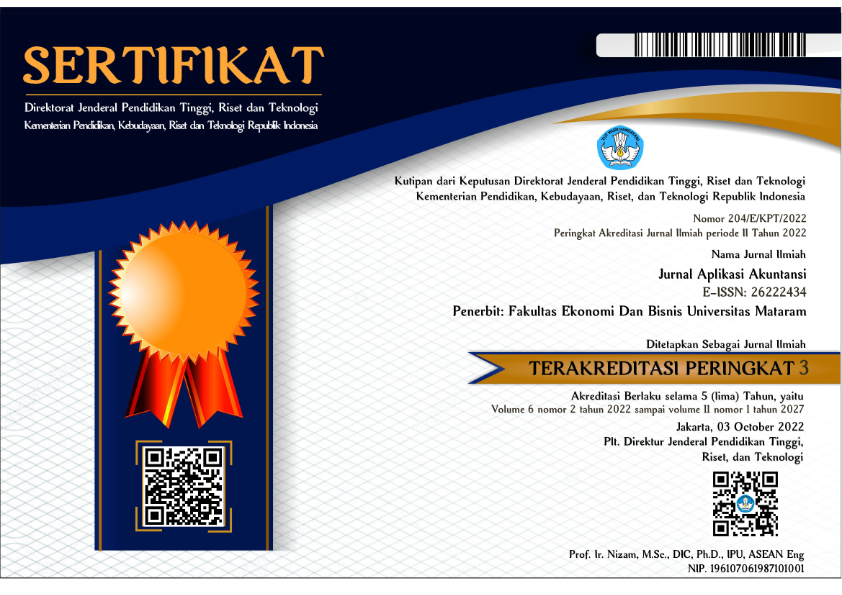TUNNELING, DETERMINANT CORPORATE TURNAROUND
DOI:
https://doi.org/10.29303/jaa.v2i1.8Keywords:
financial distress, corporate turnaround, leverage, company size, the size of the audit committee, CEO turnoverAbstract
The objective of this study is to analyze the factors that affect corporate turnaround when a company experiencing financial distress. Idependent variables used in this research are severity company, company size, expenses retrenchment, CEO turnover and dependent variable corporate turnaround. The research sample consisted of 12 financial sector companies listed on the Indonesia Stock Exchange during 2008-2010. Data were collected by using purposive sampling method.
The hypothesis testing based on multiple linear regression analysis. The result of date analysis indicated that the variableof severity company, company size, expenses retrenchmentand CEO turnover simultaneously affect the corporate turnaround. Partially, only variablecompany of size was found to have influence on corporate turnaround. Meanwhile, severity company, expenses retrenchment and CEO turnover were found to have on the corporate turnaround. R Square value shows that the no influence ability of the four independent variables in explaining the corporate turnaround success was 31.6% and the varians of corporate turnaround success 68.4% were explain by other factors that explain.
References
Barker III, V. L., and Mone, M.A. 1994. Retrenchment: Cause of Turnaround or Consequence of Decline. Strategic Management Journal,Vol. 15, Issue 5, pp.395-405.
Baroroh, Ali. 2013. Analisis Multivariat dan Time Series dengan SPSS 21. Jakarta: Elex Media Komputindo.
Bibeault, D. 1982. Corporate Turnaround: How Managers Turn Losers into Winners. Mc Graw Hill. New York.
Brutton, Garry D., David Ahlstrom, and Johnny C. C. Wan. 2003. Turnaround in East Asian Firms: Evidence from FECC.
Candrawati, Anna. 2008. Analisis Faktor-Faktor yang Mempengaruhi Keberhasilan Turnaround Pada Perusahaan yang Mengalami Finansial Distress (Studi Pada Perusahaan Non Keuangan yang Terdaftar di Bursa Efek Jakarta Tahun 2000-2005). Tesis. Universitas Diponegoro Semarang.
Casey, Cornelius J., Victor E. McGee, and Clyde P. Stickney. Discriminating 1986. Between Reorganized and Liquidated Firms in Turnaround Efforts. Academy of Management Executive, vol. 6 (3).
Damodaran, A. 1997.Corporate Finance: Theory and Practice. John Wiley. New York.
David, Fred R. 2002. Manajemen Strategis: Konsep, Edisi Ketujuh. Jakarta: PT. Prenhallindo.
Elidawati, Azhar Maksum, dan M. Lian Dalimunthe. 2015. Faktor-Faktor yang Mempengaruhi Keberhasilan Turnaround Pada Perusahaan yang Mengalami Finansial Distress di Bursa Efek Indonesia. Fakultas Ekonomi dan Bisnis. Universitas Sumatera Utara.
Emery, Dauglas R., and John D. Dinnerty. 2004. Corporate Finansial Management, Second Editor. Pearson Education, Inc.
Fauzi, Muhammad. 2011. Analisis Kinerja (Performance) Perbankan dan Pengaruhnya Terhadap Kesulitan Keuangan (Finansial Distress) Perbankan di Indonesia. Fakultas Ekonomi. Universitas Sebelas Maret. Surakarta.
Francis, John D and Desai, Ashay B. 2005. Situational and Organizational Determinants of Turnaround.Management Decision 43.
Ghozali, I. 2005. Aplikasi Analisis Multivariate dengan Program SPSS. Semarang: Badan Penerbit Universitas Diponegoro.
Hofer, C.W. 1980. Turnaround Strategies. Journal of Business Strategy, Vol. 1, Issue 1, pp. 19-31.
Jensen, M. 1989. Active Investors, LOBs and Privatisation of Bangkrupcy.Journal of Applied Corporate Finance, Vol. 2, Issue 1, pp. 35-44.
Latan, Hengky dan Selva Temalagi. 2013. Analisis Multivariate Teknik dan Aplikasi Menggunakan Program IBM SPSS 20. Bandung: Alfabeta. Lestari, Rizki Dwi dan Ni Nyoman Alit Triani. 2013. Determinan Keberhasilan
Turnaorund Pada Perusahaan yang Mengalami Financial Distress. Fakultas Ekonomi. Surabaya. Jurnal Ilmu Manajemen, Vol. 1 (4).
Lohrke, F. T., and A. G. Bedeian. 1998. Managerial Responses to Declining Performance: Turnaround Investment Strategies and Critical Contingencies. Advances in Applied Business Strategy 5: 3-20.
Makgeta, Malose. 2010. Turnaround Determinants of Distressed Firms Funded by the Industrial Development Corporation. Dissertation. University of Pretoria.
Marbun. Hendra Agustinus H., dan Chandra Situmeang. 2014. Financial Distrss dan Corporate Turnaround. Universitas Negeri Medan.
Ofek, E. 1993. Capital Structure and Firm Response to Poor Performance : An Empirical Analysis. Journal of Financial Economic, Vol. 19, Issue 1, pp.3-30.
Robbins, D.K., and J.A.II.Pearch. 1992. Turnaround: Retrenchment and Recovery. Strategic Management Journal 13 (4).
Routledge, J., and D. Gadenne. 2000. Financial Distress, Reorganization and Corporate Performance. Accounting and Finance, 40.
Sarianti. 2016. Peringkat Corporate Social Responsibility Disclosure Sebagai Strategi Managerial Entrenchment Pada Perusahaan Pertambangan yang Financial Distress. Fakultas Ekonomi dan Bisnis. Universitas Mataram.
Schendel, D.E., and G.R. Patton. 1976. Corporate Stagnation and Turnaround. Journal of Economic and Business, Vol. 28, Issue 3, pp. 236-241.
Schendel, D.E., G. R. Patton, and J. Riggs. 1976. Corporate Turnaround Strategics : A Study of Profit Decline and Recovery. Journal of General Management, Vol. 3, Issue 3, pp. 3-11.
Schuppe, Walter P. 2005. Leading A Turnaround. The Secured Lender.
Siregar, Riszky Indriyani dan Syarief Fauzie.2015. Analisis Manfaat Rasio Keuangan Dalam Memprediksi Financial Distress Pada Perbankan. Universitas Sumatera Utara.
Smith, M and C. Graves.2005. Corporate Turnaround and Financial Distress. Managerial Auditing Journal 20 (3).









